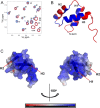NMR solution structure of the RED subdomain of the Sleeping Beauty transposase
- PMID: 28345263
- PMCID: PMC5441430
- DOI: 10.1002/pro.3167
NMR solution structure of the RED subdomain of the Sleeping Beauty transposase
Abstract
DNA transposons can be employed for stable gene transfer in vertebrates. The Sleeping Beauty (SB) DNA transposon has been recently adapted for human application and is being evaluated in clinical trials, however its molecular mechanism is not clear. SB transposition is catalyzed by the transposase enzyme, which is a multi-domain protein containing the catalytic and the DNA-binding domains. The DNA-binding domain of the SB transposase contains two structurally independent subdomains, PAI and RED. Recently, the structures of the catalytic domain and the PAI subdomain have been determined, however no structural information on the RED subdomain and its interactions with DNA has been available. Here, we used NMR spectroscopy to determine the solution structure of the RED subdomain and characterize its interactions with the transposon DNA.
Keywords: DNA binding; NMR spectroscopy; RED subdomain; SB transposase; folding; structure.
© 2017 The Protein Society.
Figures






Similar articles
-
The folding of the specific DNA recognition subdomain of the sleeping beauty transposase is temperature-dependent and is required for its binding to the transposon DNA.PLoS One. 2014 Nov 6;9(11):e112114. doi: 10.1371/journal.pone.0112114. eCollection 2014. PLoS One. 2014. PMID: 25375127 Free PMC article.
-
NMR structural analysis of Sleeping Beauty transposase binding to DNA.Protein Sci. 2014 Jan;23(1):23-33. doi: 10.1002/pro.2386. Protein Sci. 2014. PMID: 24243759 Free PMC article.
-
DNA binding and transposition activity of the Sleeping Beauty transposase: role of structural stability of the primary DNA-binding domain.Nucleic Acids Res. 2025 Jan 11;53(2):gkae1188. doi: 10.1093/nar/gkae1188. Nucleic Acids Res. 2025. PMID: 39657726 Free PMC article.
-
Sleeping Beauty Transposition.Microbiol Spectr. 2015 Apr;3(2):MDNA3-0042-2014. doi: 10.1128/microbiolspec.MDNA3-0042-2014. Microbiol Spectr. 2015. PMID: 26104705 Review.
-
The Sleeping Beauty transposon toolbox.Methods Mol Biol. 2012;859:229-40. doi: 10.1007/978-1-61779-603-6_13. Methods Mol Biol. 2012. PMID: 22367875 Review.
Cited by
-
A novel hyperactive variant of the Sleeping Beauty transposase facilitates non-viral genome engineering.Mol Ther Nucleic Acids. 2024 Nov 4;35(4):102381. doi: 10.1016/j.omtn.2024.102381. eCollection 2024 Dec 10. Mol Ther Nucleic Acids. 2024. PMID: 39654540 Free PMC article.
-
Contemporary Transposon Tools: A Review and Guide through Mechanisms and Applications of Sleeping Beauty, piggyBac and Tol2 for Genome Engineering.Int J Mol Sci. 2021 May 11;22(10):5084. doi: 10.3390/ijms22105084. Int J Mol Sci. 2021. PMID: 34064900 Free PMC article. Review.
-
Jumping Ahead with Sleeping Beauty: Mechanistic Insights into Cut-and-Paste Transposition.Viruses. 2021 Jan 8;13(1):76. doi: 10.3390/v13010076. Viruses. 2021. PMID: 33429848 Free PMC article. Review.
References
-
- VandenDriessche T, Ivics Z, Izsvak Z, Chuah MK (2009) Emerging potential of transposons for gene therapy and generation of induced pluripotent stem cells. Blood 114:1461–1468. - PubMed
-
- Mates L, Chuah MK, Belay E, Jerchow B, Manoj N, Acosta‐Sanchez A, Grzela DP, Schmitt A, Becker K, Matrai J, Ma L, Samara‐Kuko E, Gysemans C, Pryputniewicz D, Miskey C, Fletcher B, VandenDriessche T, Ivics Z, Izsvak Z (2009) Molecular evolution of a novel hyperactive Sleeping Beauty transposase enables robust stable gene transfer in vertebrates. Nat Genet 41:753–761. - PubMed
-
- Narayanavari SA, Chilkunda SS, Ivics Z, Izsvak Z (2017) Sleeping Beauty transposition: from biology to applications. Crit Rev Biochem Mol Biol 52:18–44. - PubMed
Publication types
MeSH terms
Substances
Associated data
- Actions
Grants and funding
LinkOut - more resources
Full Text Sources
Other Literature Sources

